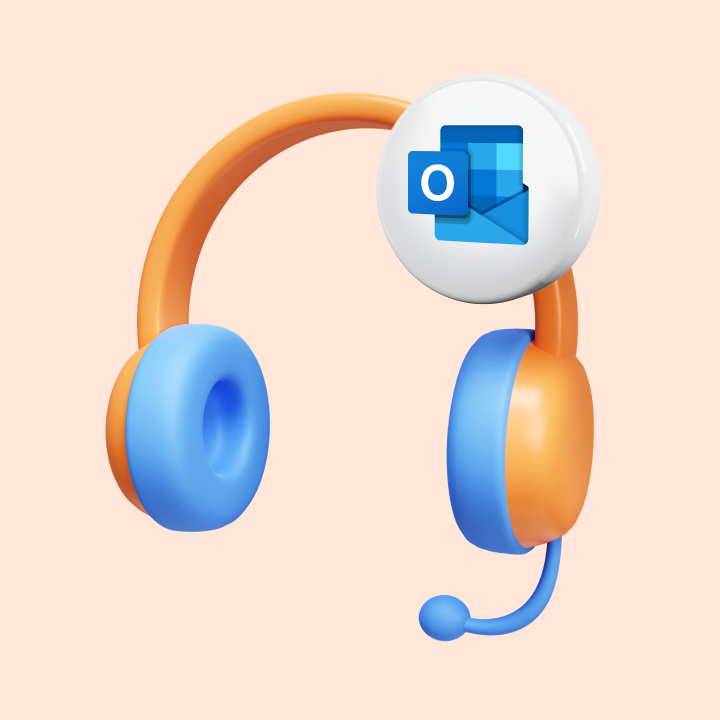Is Outlook Designed for Support Teams?
Short answer? No.
If you’ve ever tried managing customer emails from Outlook, you know how chaotic it can get. It’s hard to tell who’s handling what, so you miss some messages or your teammates reply twice.
However, using a few native features and settings in the right way, you can use Outlook as a simple helpdesk.
In this article, I’ll walk you through different ways to set up an Outlook ticketing system, including our personal favourite, Hiver, which adds complete helpdesk functionality directly to your Outlook inbox.
Table of Contents
- Is Outlook Designed for Support Teams?
- Quick Summary
- Why Trust Us?
- What is Outlook Help Desk?
- Benefits of Outlook Help Desk
- How to Use Outlook as a Helpdesk?
- Limitations of Using Outlook as a Helpdesk
- 1. No feature to assign emails automatically
- 2. No visibility of the team’s workload and the status of queries
- 3. No feature to track agents’ performance
- 4. No features to facilitate team collaboration
- 5. Lack of proper reporting features to gauge customer satisfaction
- 6. Lack of SLA and Automation
- 7. Limited Reporting and Analytics
- 8. Collaboration Challenges in Shared Mailboxes
- Outlook Integrations vs. Dedicated Help Desk: A Comparison Table
- Signs It’s Time to Upgrade from Outlook
- How Hiver Turns Outlook Into a Full-fledged Help Desk
- Hiver Integration vs Manual Outlook Ticketing System Setup
- Features to Look For in an Outlook Help Desk
- Turning Outlook Into a Scalable Help Desk
- Frequently Asked Questions (FAQs)
Quick Summary
Looking to create an Outlook ticketing system for customer support? This guide explains how to use Outlook’s built-in features, such as shared mailboxes, rules, and canned responses, to change Outlook into a basic helpdesk. You’ll also learn why teams choose Hiver for Outlook, which adds automation, collaboration, and AI features to your support inbox.
Why Trust Us?
We try every tool ourselves, cross-check it with user reviews, and compare it against clear criteria such as ease of use, key features, integrations, and support. Our team works closely with CX leaders and sees what actually works in day-to-day operations.
With over 10,000 teams trusting Hiver, we’ve learned what makes customer service software truly dependable. So, you get straightforward, unbiased recommendations – nothing more, nothing less.
What is Outlook Help Desk?
You can have Outlook as a help desk by using it as a basic ticketing system. In simple terms, instead of buying a separate platform, teams adapt Outlook’s built-in features to manage support requests in one place.
With shared mailboxes, rules, and templates, Outlook can act as a lightweight helpdesk where:
- All customer support queries arrive in a shared inbox.
- Emails are assigned to the right people and tracked until resolved.
- Standard replies keep responses fast and consistent.
This setup answers the question for certain teams: how to create a ticketing system in Outlook? It’s a cost-effective way to manage queries when the volume is low and the support process is straightforward.
However, Outlook may lack advanced features compared to a dedicated ticketing system. Features like automation, tracking, and reporting, which become essential as customer support scales, are missing. As your support requests grow, a full-fledged help desk may be required.
Benefits of Outlook Help Desk
An Outlook ticketing system can not replace a full-fledged dedicated help desk. However, it does give small teams a way to manage support without extra tools or costs. Here’s what makes it useful:
1. Familiar setup: Turning Outlook into a help desk means there’s nothing new to install or learn. This is especially useful if your team is already using Microsoft Outlook.
2. Cost-effective: Outlook is already part of your Microsoft 365 subscription. There are no additional licenses or hidden fees. This can delay the need for heavy software for startups or lean teams until support volumes grow.
3. Centralized communication: All support emails land in one shared mailbox instead of sitting in personal inboxes. That means no lost conversations, missed follow-ups, and no need to chase down who replied to what.
4. Basic automation: Rules let you reduce repetitive work. For example, a billing query can route directly to finance, or an urgent email can be flagged before anyone even opens it. Simple changes like these reduce time wasted on manual sorting.
5. Faster, consistent replies: Templates save minutes on common questions like refunds, order status, and password resets. They also ensure that every customer hears the same clear message.
6. Works for light support needs: If you’re handling a manageable volume of requests, Outlook as a help desk can keep things structured without the overhead of a full system. It’s not built for scale, but it works well as a starting point.
7. Basic metrics tracking: Outlook lets you track email volume, monitor storage limits (50–100 GB), and use categories or labels to roughly group queries like “Billing” or “Orders.”
Together, these features make an Outlook ticketing system. It becomes a basic help desk system that can handle everyday support. But as your team grows, its limitations quickly start to show.
How to Use Outlook as a Helpdesk?
It might sound unconventional, but you can turn Outlook into an improvised helpdesk using these three built-in features:
- Shared Mailbox
- Rules and Filters
- Canned Responses
However, setting these features up can be tricky and time-consuming. If you’d rather skip the hassle, Hiver for Outlook provides full helpdesk functionality within the same inbox you already use, automating ticket assignment, collaboration, and tracking without the limitations of Outlook.
While Outlook has its limitations, its built-in features are surprisingly effective for creating a basic helpdesk. The key is knowing how to set them up, and we’ll guide you through the process.
1. Shared mailbox
A shared mailbox in Outlook is a centralized account that multiple users can access and manage support requests. It’s designed for shared workloads and is perfect for customer support teams where incoming queries need to be visible.

For example, with the help of a shared mailbox in Outlook, you can create a common mail ID (ex: support@yourbusiness.com) and give access to this mailbox to your team members. So, instead of each team member checking their own inbox, they all have access to a shared “Support” mailbox.
Now, when you receive an incoming query, anyone on the team can jump in and respond promptly. This ensures that every customer gets a timely response, no matter who handles the email.
Here’s how to set up a shared mailbox in Outlook:
Step 1: Create a new shared mailbox in your admin settings.

Step 2: Add teammates who should have access.

Step 3: Set permissions (read-only, send-only, or full access).
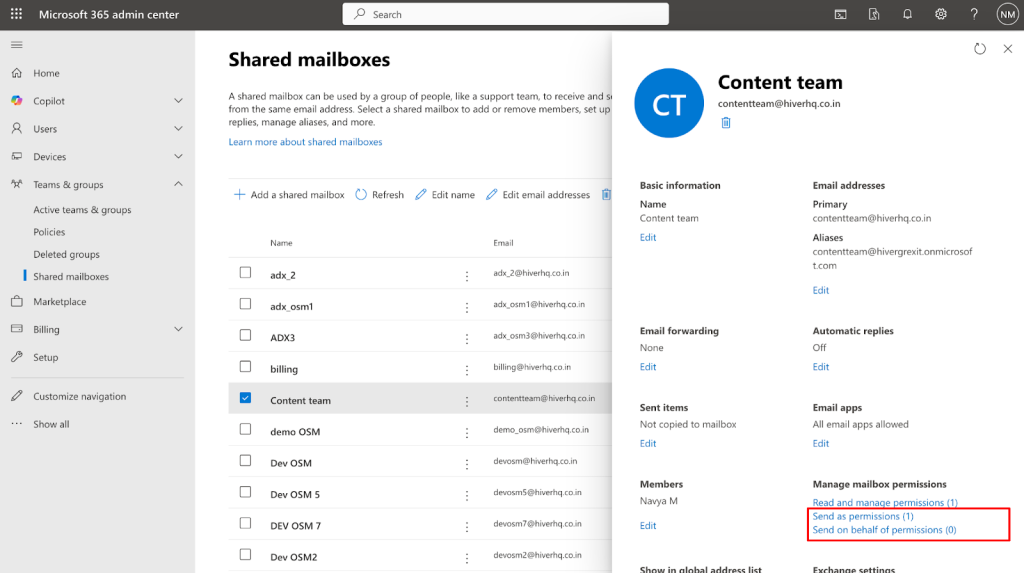
To sum up, here’s how a shared mailbox can benefit your support team:
- Centralized communication: With a single mail address, a shared mailbox mimics the functionality of a helpdesk by keeping all customer queries and conversations in one place.
- Team access: Team members can access, read, and reply to support queries. This saves you from the hassle of forwarding and cc-ing teammates.
- Permission-based access: Depending on the nature of their work, you can give your teammates different levels of access, such as read-only, send-only, or full access.
But here’s something important to note. Although you may feel that Outlook’s shared mailbox can transform your inbox into a functional helpdesk, it may not be entirely true. Users have found multiple glitches and limitations while handling support requests using a shared mailbox in Outlook.
To begin with, shared mailboxes are not available in all versions of Outlook. Users have found that this feature is unavailable in the new Microsoft Outlook interface.

Users have also mentioned a couple of other inefficiencies of the shared mailbox in Outlook, like not being able to add signatures and the inbox taking time to sync up when switching devices.
“I can see issues like mail sent doesn’t land in the sent folder of the shared mailbox, or no standard signatures for shared mailbox. I can also see issues with not updating enough if opening in Outlook app and users need real time with other users who access.”
– User review on Reddit
So, to sum up, Outlook’s shared mailbox can be a practical solution for small teams, but it has quite a few issues that can hinder your support team’s efficiency.
2. Rules and filters
Once a shared mailbox is set up, the next challenge is staying organized. This is where Outlook’s rules and filters help. They let you automatically sort, tag, or forward emails based on conditions you set.
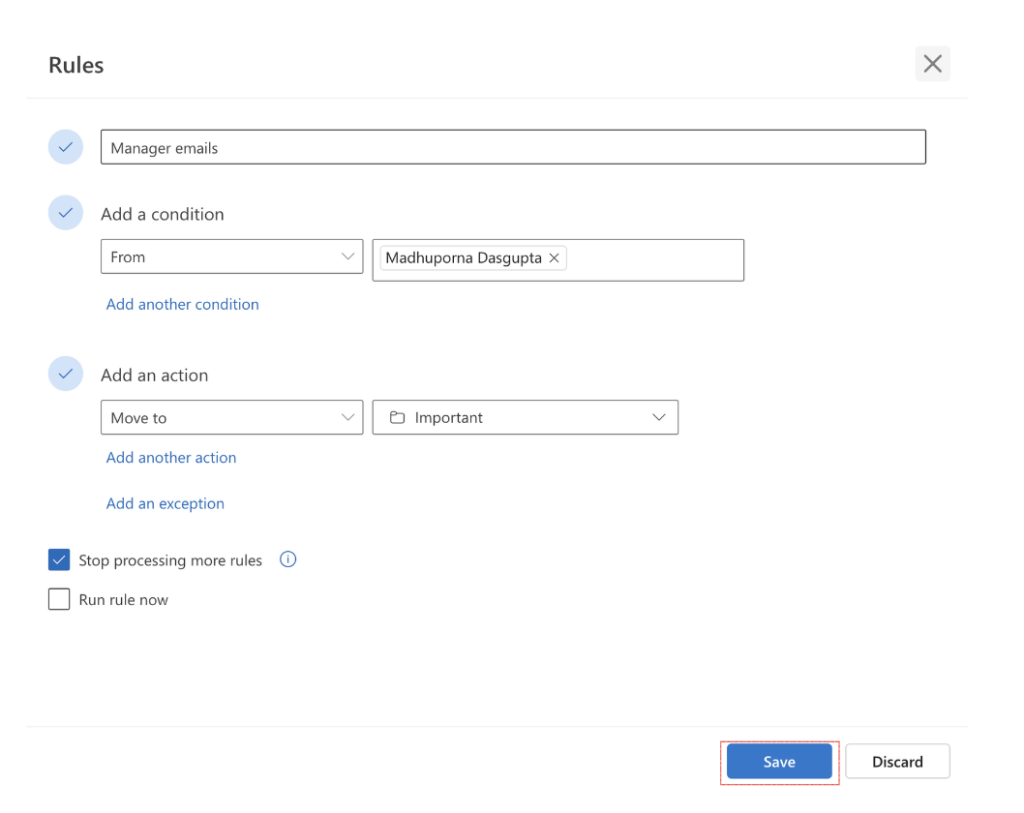
Let’s take an example. Suppose you get a lot of billing and invoice-related queries from your customers in your shared mailbox. And you want to forward them to your Finance department so that someone from that team can directly take over.
With rules, you can automate this process without having tomanually forward them to the specific department. You can create rules to forward emails to the Finance department based on keywords like “billing,” “invoice,” “payment,” and more in the subject line or body of the email.
Here’s how to create rules and filters in Outlook based on your specific criteria.
Step 1: Open your browser, head to Outlook, and log in.
Step 2: Click the gear icon in the top right, then select “View all Outlook settings.”

Step 3: In the settings window, go to Mail, then Rules.
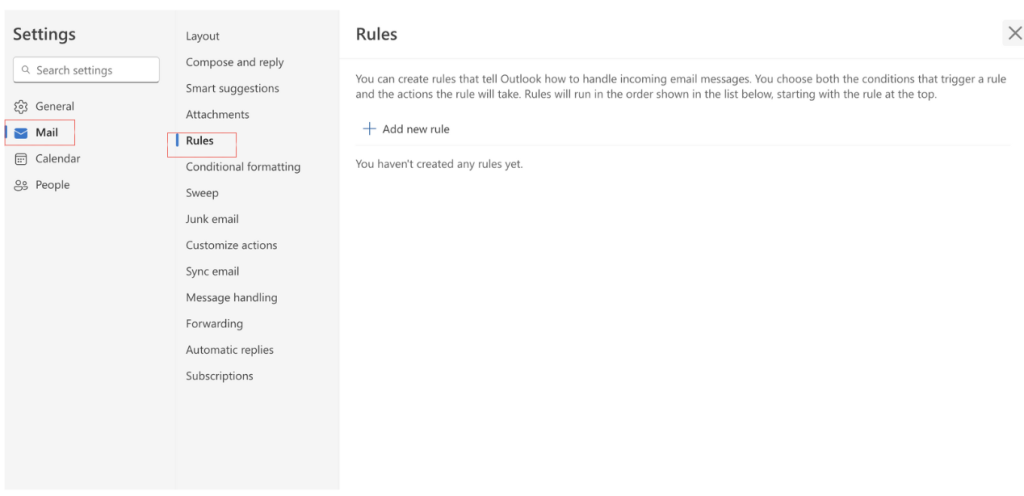
Step 4: Click “Add new rule.”

Step 5: Give your rule a name you’ll recognize later, something like Manager Emails.
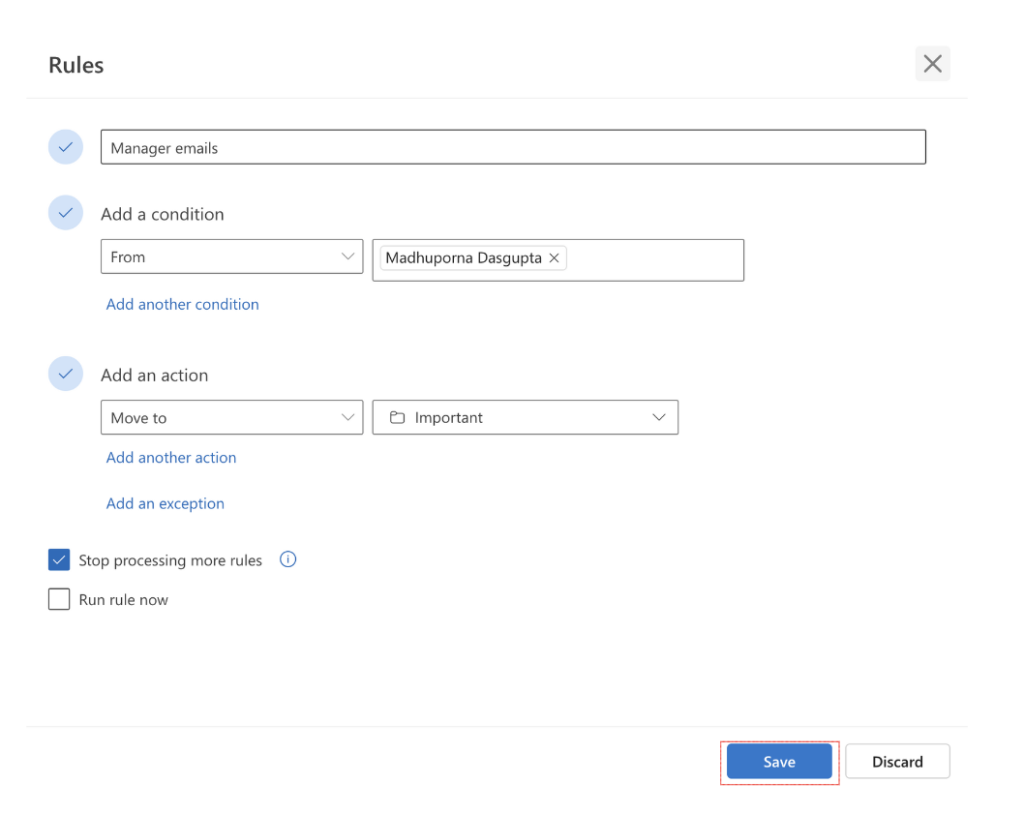
Step 6: Under “Add a condition,” choose what to filter. For example, pick From and enter your manager’s email address.

Step 7: Under “Add an action,” choose what should happen. For instance, select Move to, create a new folder called Important, and save it.

Step 8: Hit Save to finish.
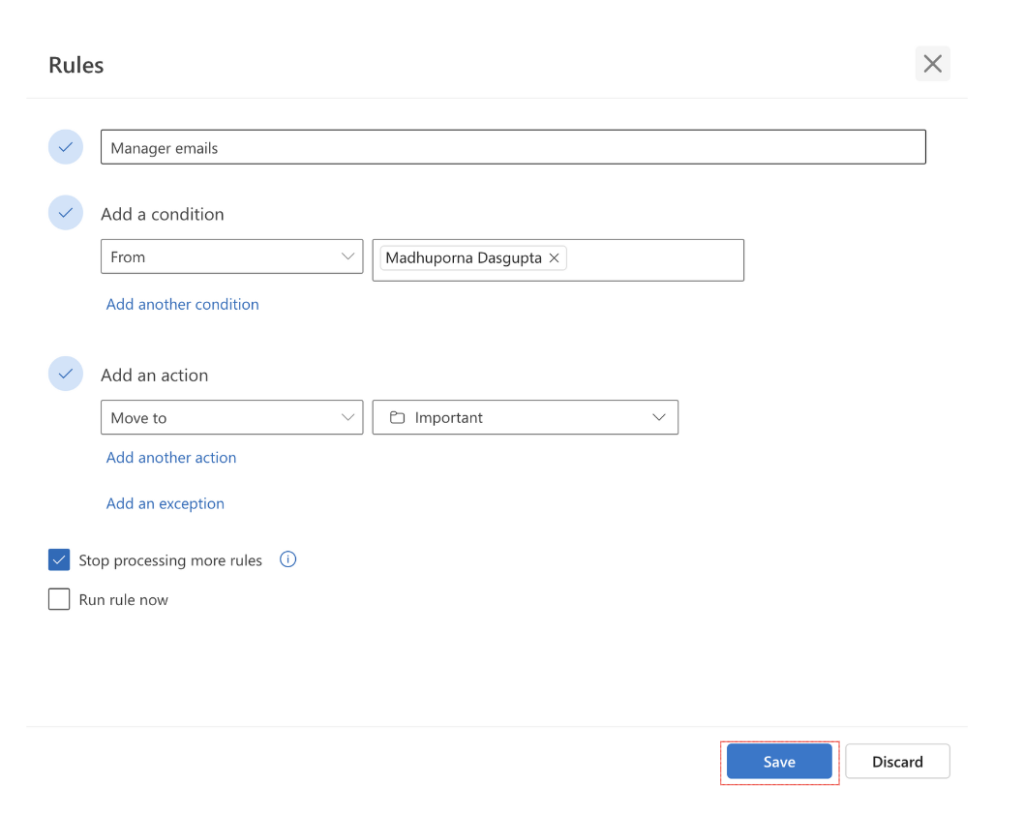
Benefits of setting up rules in Outlook
- Automation: Rules are essentially automations. They help you automatically categorize and prioritize the emails received in your shared mailbox, reducing your team’s manual workload.
- Timely responses: You can flag important and urgent emails automatically with the help of rules. This ensures that important emails are quickly attended to, providing timely responses.
- Organization: Setting up rules ensures that your inbox stays tidy and organized so that nothing slips through the cracks.
Rules and filters in Outlook are quite functional. But many users have pointed out their inefficiencies, especially when you set up rules in shared mailboxes.
Users have explained that sometimes, rules in Outlook’s shared mailboxes don’t work properly.

Users have also pointed out that you need to have full access to the shared mailbox to create rules. This means teammates with “read-only” or “send-only” permissions may not be able to set up rules.
Another user has also mentioned that rules are not that easy to create in a shared mailbox. It takes a bit of learning to master it.
“….Without the rules being directly on the shared mailbox, you will get lots of inconsistencies. Whenever I create a new shared mailbox I send a document to the users associated with it that shows how to properly create the rules, how to send on behalf of, etc.”
–User review on Reddit
3. Canned responses/templates
Templates or canned responses are pre-written emails that can be used to answer common customer queries quickly. Templates can improve your response time since you do not have to write the email from scratch every time. You can just customize the placeholders and hit send.
Here’s an example of a template that can be customized as per user requirements
Subject: Your Order Status
Dear [Customer Name],
Thank you for your order with [Your Company]. We wanted to inform you that your order #[Order Number] is currently [Order Status].
The estimated delivery date is: [Date]
If you have any questions or need further assistance, please feel free to reach out to us.
Best regards,
[Your Name]
[Your Position]
[Your Company]
With Outlook, you can create and save templates that you can use later. Here’s how to create and save templates in Outlook.
Step 1: Click New Mail in the top-left corner to start a new email.

Step 2: Go to the Insert tab, click Apps, and select My Templates. (If you don’t see it, click Get add-ins and search for My Templates.)

Step 3: Click +Template to create a new one.
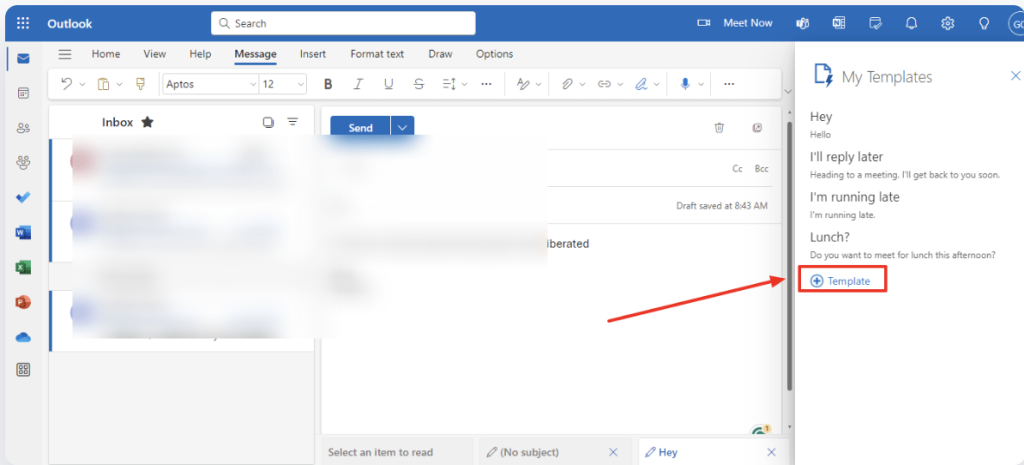
Step 4: Write your subject and body text just like a normal email, then hit Save. Your email is now stored as a template.

Step 5: To use it later, open a new email, go to Insert, then Apps, then My Templates, and select the one you saved.

Step 6: Personalize it, i.e., update names or details, and then hit Send.
Here are some benefits of using email templates in Outlook:
- Improves response times: As mentioned earlier, using stored templates to answer common customer queries allows your team to respond almost immediately. This improves response time since they don’t have to draft an email every time.
- Ensures consistency in communication: Pre-written templates ensure that your customers receive high-quality information, irrespective of who responds to them. They also ensures a consistent and professional tone when communicating with your customers.
Recommended reading
Limitations of Using Outlook as a Helpdesk
While Microsoft Outlook can be a good starting point for managing incoming support queries, it cannot be a helpdesk. It lacks the functionalities of a robust helpdesk, which can hamper your support team’s efficiency in delivering exceptional customer support.
Here are some of the limitations of using MicrosoftOutlook as a helpdesk:
1. No feature to assign emails automatically
Outlook doesn’t have a built-in, dedicated ticketing system. So, it becomes hard to assign individual emails automatically. Sure, you can create rules to automatically send emails to your teammates based on specific criteria, but this can be done when you have a small team of 2-3 support staff.
But when you have to assign large volumes of emails to multiple teammates, it gets rather complicated. Also, it’s almost impossible to assign queries in a round-robin manner with Outlook’s rules feature.
Recommended reading
2. No visibility of the team’s workload and the status of queries
Outlook’s shared mailbox doesn’t have the feature to track the status of queries (if they are pending or closed). You’ll have to take updates directly from your team members or closely follow the conversation through email threads. This can be pretty time-consuming.
As Marti Clark put it on our Experience Matters podcast,
“The biggest lesson was learning prioritization. Without it, everything felt urgent, and that’s not scalable.”
3. No feature to track agents’ performance
There’s no proper way to monitor the performance of your support staff. In order to track their performance you need access to important metrics like number of issues handled by each agent, response time, resolution rate and so on. Outlook doesn’t offer any way to measure these.
4. No features to facilitate team collaboration
It can get particularly difficult to work in a shared mailbox without proper collaboration features. Since there’s no visibility, agents may not know which queries are being handled and which aren’t.
Also, if two agents respond to the same query, it can confuse the customer. Similarly, if everyone assumes someone else is handling a query, chances are that the query will go unanswered.
5. Lack of proper reporting features to gauge customer satisfaction
Outlook cannot measure important metrics like response time, resolution time, and CSAT scores. Without these metrics, you won’t be able to measure your customers’ satisfaction and identify any scope for improvement.
In fact, businesses often use CSAT surveys to measure customer satisfaction. However, there is no built-in option to integrate these surveys into customer emails. The only way to do this would be to incorporate such survey tools with Outlook, which may cost additional money.
6. Lack of SLA and Automation
Meeting response and resolution deadlines is non-negotiable in customer support. Outlook, however, offers no way to define or track SLAs (Service Level Agreements). It also lacks automation workflows to escalate overdue tickets or remind agents when deadlines are approaching.
That’s a big miss, because 77% of customers say valuing their time is the most important thing a company can do (Forrester).
If your team finds itself manually checking timestamps or chasing down overdue queries, Outlook has already reached its limit.
7. Limited Reporting and Analytics
Managers need metrics like response times, resolution rates, backlog size, and customer satisfaction to coach teams and improve service. Outlook doesn’t provide any of this. There are no dashboards, no agent-level breakdowns, and no way to spot trends.
Yes, you can export raw data and build reports in Excel or Power BI, but that means hours of spreadsheet work every week. And with Microsoft research showing the average employee already deals with 117 emails and 153 Teams messages daily, most support teams simply don’t have the bandwidth.
Here’s what Outlook leaves out:
- First Response Time (FRT): No way to see how long customers wait for a reply.
- Resolution time: Can’t track how long tickets stay open or when they’re actually solved.
- Agent-level performance: No breakdown of who handled how many queries, or their average speed.
- CSAT: No built-in survey integration or tie-back to email threads.
👉 Why this matters: Without FRT, resolution, or CSAT, you can’t measure service quality or hold SLAs accountable. You’re managing blind.
Outlook lets you count emails and storage, but not much else. You’ll never know if customers got timely replies, how long issues stayed unresolved, or how satisfied they were.
If your reports live in spreadsheets instead of dashboards, the question you have to ask isn’t “Can Outlook track enough?”, it’s “How much longer can we afford not to upgrade?”
8. Collaboration Challenges in Shared Mailboxes
Outlook doesn’t let you assign ownership, leave internal notes, or see who’s working on what. This leads to two common outcomes:
- Duplicate replies, where multiple agents respond to the same customer
- Missed emails, where everyone assumes someone else is handling the query
You can set up workarounds like using labels, initials, or external trackers, but they add friction and are easy to forget. Once your team grows beyond 3–4 members, Outlook’s shared mailbox becomes a liability. Customers notice when two agents reply to the same email or when nobody replies at all. These gaps can also damage trust.
Alright! I get it! Outlook has a bunch of limitations. And you might be thinking: “Getting a separate help desk means new software, training my team, and migrating all our customer queries. Is it really worth it right now?”
That’s a fair concern. The truth is, you don’t have to make the leap immediately. There are workarounds and extensions you can use to stretch Outlook a little further, from Power Automate flows to third-party survey tools and productivity add-ins.
We’ll look at those next, along with the metrics Outlook can (and can’t) give you, and the signs that tell you it’s time to move beyond Outlook altogether.
Outlook Integrations vs. Dedicated Help Desk: A Comparison Table
Here’s a quick comparison between Microsoft Outlook integrations and a dedicated help desk.
| Aspect | Outlook Integrations | Dedicated Help Desk |
|---|---|---|
| Email Routing | Power Automate flows can forward/flag emails, but break with complex rules. | Built-in auto-assignment (round-robin, skill-based, SLA-based). |
| CSAT Tracking | Add a survey link with Forms or Typeform; manual tracking in Sheets. | Native CSAT/NPS surveys tied directly to tickets. |
| Collaboration | Use labels/initials, but no real ownership or internal notes. | Clear ticket ownership, notes, @mentions, collision alerts. |
| Reporting | Manual exports to Excel/Power BI; time-consuming. | Dashboards for FRT, resolution, backlog, CSAT, agent performance. |
| Automation | Limited to basic flows/alerts. | Advanced workflows: escalations, SLA alerts, auto-tagging, integrations. |
| Scalability | Works for ≤ 40–50 emails/day, small teams. | Handles thousands of tickets, multi-team, multi-channel. |
If you’re not ready for a dedicated help desk yet, here are a couple of integrations that can make Outlook more usable for support teams:
1. Using Power Automate for Basic Ticket Routing
Power Automate lets you build flows that trigger when emails hit your shared mailbox. Three practical setups you can create:
- Route emails based on keywords like “invoice,” “refund,” or “outage” to specific folders or teammates. For example, when an email arrives in the shared mailbox and its subject contains “invoice” or “payment,” it will be forwarded to the finance team or moved to the billing folder.
- Send alerts when an email sits unopened for a set number of hours. For example, when an email is older than 4 hours and unread, send a Teams notification to the support channel.
- Trigger actions in Teams or Planner, like creating a follow-up task when a new email arrives in the shared mailbox. For example, when an email is flagged as “Important”, it creates a Planner task with the subject line as the task name.
👉 Tip: Keep flows simple (≤3 conditions). Complex flows often break without warning, and no one notices until customers complain.
2. Outlook Add-ins and Plugins for Productivity
There’s a wide range of add-ins available in the Microsoft AppSource marketplace. For support teams, the most useful are:
- Template/snippet managers for faster replies.
- Task or project connectors to sync emails with tools like Trello or Asana.
- Analytics-lite plugins that give rough counts or trends on email activity.
These can improve daily efficiency, but be careful not to overload Outlook with too many add-ins. This in turn can slow performance and confuse teammates.
👉 Tip: Standardize across your team. Decide on 2–3 approved add-ins, document how to use them, and roll them out consistently. Otherwise, you’ll end up with five people using five different tools.
Signs It’s Time to Upgrade from Outlook
Microsoft Outlook can handle the basics, but there are clear signals when it’s no longer enough. If two or more of these apply to your team, it’s time to move beyond Outlook.
1. Growing Ticket Volumes and SLA Pressure
- As we previously discussed, an average worker can get more than 100 customer emails a day.
- Agents spend more time searching and forwarding than solving issues.
- SLAs are missed because there’s no way to track or escalate overdue emails.
2. Multi-Team or Multi-Channel Support Needs
- Different departments (finance, ops, tech) are all pulling requests from the same shared mailbox.
- Customers want to reach you through chat, phone, or WhatsApp, but Outlook only covers email.
- You’re constantly forwarding threads across teams, losing context along the way.
3. Customer Experience and Visibility Gaps
- Customers receive duplicate replies or worse, no reply at all.
- No one can clearly answer: “Who owns this ticket, and what’s its status?”
- Weekly reports take hours to compile and still don’t show satisfaction or trends.
If these issues sound familiar, Outlook can be blocking you from scaling. At this stage, the answer isn’t abandoning email altogether. It’s adding a help desk layer on top of Microsoft Outlook. Take a look at how Hiver can help you with that.
How Hiver Turns Outlook Into a Full-fledged Help Desk
Hiver is a powerful helpdesk that can turn your Outlook inbox into an AI-powered help desk. It builds on the inbox you already use and adds the structure, automation, and reporting that Outlook lacks.
Hiver’s interface mirrors your Outlook inbox. So there’s no need for you or your team to learn a new software completely. You can continue to use the interface you are comfortable with, but with added functionalities to make your job easier!
So, it’s the best of both worlds, isn’t it?
Let’s see how Hiver addresses Outlook’s limitations:
1. Route, track, and get complete visibility of queries within Outlook
Like Outlook, Hiver offers a shared inbox functionality, which creates a centralized location for all incoming customer queries. You can assign queries to your teammates manually or automatically from the shared inbox.
This visibility is critical. As Greg Melia explained in the Experience Matters podcast,
“It’s not just about one-off interactions. It’s about building a system where the entire team has visibility into the customer journey.”
Hiver brings that system into Outlook.

And it doesn’t end there. You can even track the statuses of the incoming queries within the shared inbox.
Hiver’s integration with Outlook allows your team to keep track of the queries assigned to them on the left panel of Outlook’s interface. They also get a clear view of which emails are assigned to whom, giving complete visibility of the team’s workload.
2. Collaborate with your team without CCs and forwards
Hiver adds collaboration features directly into Outlook, like:
- Notes and @mention: If you need to seek approval or share insights on a particular query, add a note beside the email thread and tag the stakeholder involved.

- Conversation followers: This feature enables managers and supervisors to follow an email thread to keep themselves informed about the conversation with the concerned customers. This is particularly useful in cases of escalations.
- Collision alerts: This feature alerts your teammates when they’re going to pick up a customer query that a colleague has already started working on.
3. Automate ticket distribution and SLAs
With Hiver, you can automatically assign queries to your teammates. Hiver allows you to set up rules automatically distributing emails to your team based on predefined criteria. You can automate round-robin assignments to ensure that your team’s workload is evenly distributed.

You can also create rules to trigger skill-based query assignment based on your teammates’ areas of expertise. For example, with Hiver, you can automatically assign a technical query to an IT specialist.
4. Measure your team’s performance and customer satisfaction metrics
Hiver offers detailed reporting and analytics features that help you measure agent performance, response time, and other customer satisfaction metrics. You can identify your top-performing agents and even make data-driven decisions to improve your business’s support operations

With Hiver, you can also send CSAT surveys within your email conversations. There’s no need to integrate a separate survey tool. This ensures that you get to measure your CSAT scores almost instantly.
Recommended reading
6. AI capabilities
If you’ve ever opened your inbox to find hundreds of customer emails waiting, you know the first hurdle isn’t always answering them. It’s usually figuring out where to start. Which ones are urgent? Who should take them? And once they’re routed, how do you make sure responses are quick, clear, and on-brand?
Hiver AI can help you with this. AI triage takes care of the sorting and routing, while AI Copilot helps your team respond faster and more confidently. Together, they remove the grunt work so agents can focus on solving real problems. And AI Insights gives managers a clear view of patterns, bottlenecks, and customer sentiment, so you can improve processes instead of reacting to issues too late.
Let me explain how they do that,
- AI Triage: Classifies and routes incoming emails by intent, urgency, or sentiment.
- AI Copilot: Suggests draft replies, adjusts tone, summarizes long threads, and pulls knowledge base answers instantly.
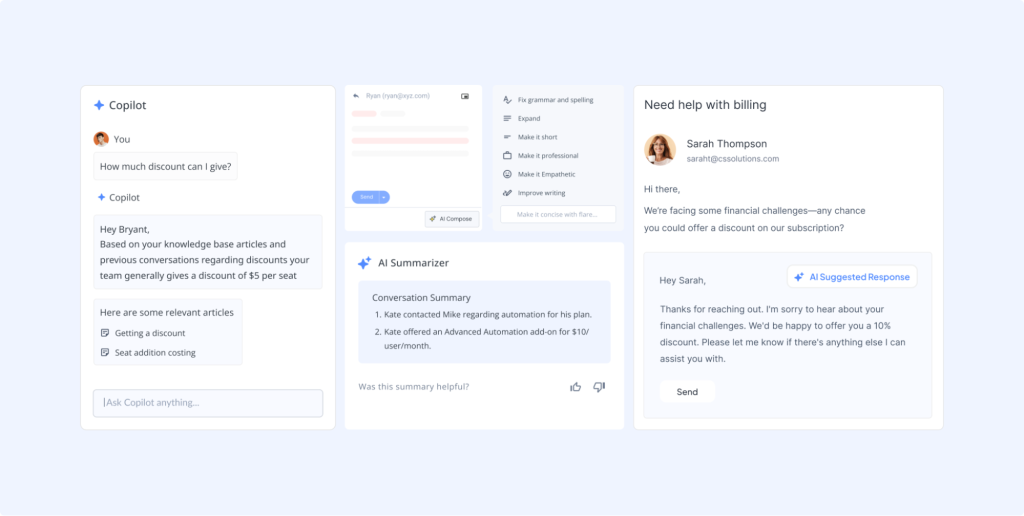
- AI Insights: Highlights recurring issues, bottlenecks, and customer sentiment trends, so you improve processes instead of firefighting.
Hiver Integration vs Manual Outlook Ticketing System Setup
| Feature | Manual Outlook Ticketing System | Hiver for Outlook Integration |
|---|---|---|
| Routing | Forwards or flags emails; may break with complex rules | Automatically routes, assigns, and tracks queries from a collaborative inbox |
| Email Templates | Basic, limited customisation | Shared, flexible customisation, with dynamic fields |
| Collaboration | Uses labels or initials; requires CC/BCC | Add internal notes, @mention teammates, and get collision alerts |
| Analytics and Reporting | No analytics. Reports are manually exported to Excel/Power BI | Detailed real-time analytics and performance reports directly inside Outlook |
| Automation | Limited to manual setup rules and filters, prone to glitches | Automated workflows, skill-based assignments, and SLA tracking |
| AI Functionality | No native AI | AI Triage routes emailsAI Copilot drafts responsesAI Insights highlights patterns and trends. |
| Scalability | Works for ≤ 40–50 emails/day | Scales effortlessly for high-volume teams |
Features to Look For in an Outlook Help Desk
If you’re serious about using Outlook for customer support, it helps to know what features truly make a difference. A basic setup (shared mailboxes, rules, templates) works at low volumes, but you’ll need capabilities that Outlook alone doesn’t provide as queries grow.
Here are the must-have features in an Outlook help desk:
- Automatic ticket assignment: Emails should be distributed fairly across your team, either round-robin or skill-based, so no one is overburdened and nothing slips through.
- Real-time status tracking: Every query should have a clear status (open, pending, closed) with visibility into who owns it. This prevents duplicate responses and missed follow-ups.
- Collaboration tools: Agents need ways to share context, ask for approvals, and avoid working on the same email. Features like internal notes, mentions, and collision alerts help reduce confusion.
- SLA management: Support teams should be able to define response and resolution deadlines, set alerts, and escalate tickets automatically when deadlines are missed.
- Reporting and analytics: Managers need insight into agent workload, response times, resolution rates, and customer satisfaction scores. Without this data, it’s impossible to track progress or improve operations.
- AI assistance: Modern help desks use AI to triage incoming queries, route them to the right agents, and even suggest responses. This saves hours of manual effort and ensures faster resolutions.
- Multi-channel support: A complete Outlook help desk should also let you handle chat, phone, and messaging apps from the same interface.
- Self-service options: A built-in knowledge base helps customers solve common issues on their own, reducing ticket volume and freeing your team for complex queries.
Turning Outlook Into a Scalable Help Desk
Outlook can carry a team through the early days of customer support. Shared mailboxes, rules, and templates give just enough structure to keep small volumes under control.
But as volumes grow, the cracks start to show. Outlook alone doesn’t offer ticket assignments, SLA tracking, team visibility, or performance reporting. These gaps make it hard to deliver fast, reliable support at scale.
That’s where dedicated Outlook help desk tools come in. Platforms like Hiver build on Outlook’s familiar interface but add what’s missing, like automation, SLA tracking, AI triage, collaboration features, and reporting.
The result is a system that feels just as simple as your inbox, but powerful enough to scale with your team.
Interesting, isn’t it? Try it for free
Frequently Asked Questions (FAQs)
Can I use Outlook as a helpdesk for a small team?
Outlook can be a practical help desk for small teams, especially if you leverage shared mailboxes and configure rules and filters to manage emails. However, as your team and the volume of support requests grow, you may encounter limitations that could hinder efficiency.
How do I organize emails in Outlook’s shared mailbox?
You can organize emails in a shared mailbox by creating folders and subfolders and using categories and flags to prioritize and categorize emails. Setting up rules to automatically move emails to specific folders based on criteria like sender or subject can also help maintain an organized inbox.
Can multiple users send emails from a shared mailbox?
Yes, multiple users can send emails from a shared mailbox if they have the necessary permissions. Emails sent from the shared mailbox will appear as if they are sent from the shared email address (ex, support@yourbusiness.com)
Are there any storage limits for shared mailboxes in Outlook?
Shared mailboxes in Office 365 come with a default storage limit of 50 GB. This limit can be increased to 100 GB, but you must subscribe to a higher plan. If you exceed the storage limit, you may have to archive old emails or upgrade your subscription plan.
Can I use Hiver with any email provider?
Hiver works with Google Workspace (Gmail) and Microsoft 365 (Outlook). If your team uses another inbox, you can still manage support from Hiver’s dashboard, which gives you one place to assign, track, and automate queries.
What kind of support does Hiver offer?
Hiver offers 24×7 customer support through chat and email. It also offers various support options, including a knowledge base and video tutorials.
What is the best Outlook-compatible helpdesk software for SMBs?
For SMBs using Outlook, Hiver is a great option. It works mimics the interface of Outlook, adding automation, SLA tracking, and collaboration features without the complexity of a traditional helpdesk.
Best helpdesk platforms for Gmail/Outlook remote teams in 2025
In 2025, Freshdesk, Zendesk, and Hiver are among the best options for Gmail and Outlook teams. Freshdesk and Zendesk offer advanced workflows, while Hiver suits agile teams that want to manage support from the inbox itself.
What’s the best helpdesk platform for Gmail/Outlook-based teams with remote agents?
Freshdesk, Zendesk, and Hiver are strong choices for remote teams on Gmail or Outlook. Hiver works directly in the inbox, while Freshdesk and Zendesk provide more advanced automation and reporting for distributed teams.
What are the best helpdesk tools with Outlook and Microsoft 365 support?
Helpdesk 365, Zendesk, and Hiver all integrate with Microsoft 365. Hiver adds ticketing, SLA tracking, and collaboration inside Outlook, while the others extend Outlook with broader workflows and analytics.
Can I automate ticket assignment in Outlook?
Not fully. Outlook rules can forward emails or move them into folders based on keywords, but they can’t distribute tickets fairly across agents (round-robin or skill-based). If you need balanced workload and SLA tracking, you’ll need a dedicated help desk layer like Hiver.
How many agents can realistically share one Outlook mailbox?
For very small teams (2–3 agents), a shared mailbox can work. Once you hit 4+ people, you’ll start running into duplicate replies, missed emails, and zero visibility into ownership. That’s when Outlook stops being efficient.
Does Outlook support customer satisfaction surveys?
No. Outlook has no built-in CSAT or feedback collection. The workaround is to embed links to third-party surveys (Microsoft Forms, Google Forms, Typeform) in your closure templates and track responses manually in a sheet. If you want CSAT tied directly to conversations, you’ll need a help desk tool.
When should I switch to a dedicated Outlook help desk tool?
The moment volume crosses 40–60 support emails a day, SLAs are slipping, or multiple teams need to collaborate, Outlook becomes a bottleneck. If you’re spending hours on manual trackers or customers are complaining about delays and duplicate replies, it’s time to move to a proper Outlook help desk tool.
 Skip to content
Skip to content



